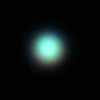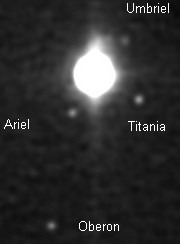

Because Mars was envolped with a dust storm most of the summer of 2001, I tried my hand at Uranus. All images were taken with a 9" Newtonian, using the AO-2 to project to F/60 onto an SBIG ST-7E camera with SBIG color filter wheel. Between 11 and 22 single exposures of 10 second for each color were combined into a single RGB image. MaxIm DL software was use to perform maximum entropy processing and color combining. The processing was limited to assure no artifacts were generated. Some residual color on the edges is due to atmospheric turbulence making the different color frames slightly different in shape and size. Because clouds were variable during the exposures, the true color could not be based on the standard exposure ratios; the color is rather arbitrary.
Uranus gets to about 45 degrees above the horizon, where the seeing is fair, with an Airy disk seen much of the time. Using long exposures (without the AO-2) averages out the turbulence. The drive was recently fine tuned to reduce PEC to about an arcsecond RMS, allowing these relatively long exposures without guiding. Uranus was 3.7 arcsec diameter when this image was taken.August 25, 2001


Four of Uranus's moons can be seen in this image taken with a visible filter (IR blocked). Each exposure was 30 seconds long, and the best 9 were combined for an equivalent exposure of 270 seconds. The time was approximately 11pm PDT. According to Guide7, Uranus's magnitude was 5.7, while Titania was 13.9, Oberon was 14.1, Ariel was 14.3, and Umbriel was only 14.9. This makes Umbriel, only 11 arcsec from Uranus's edge, about 5000x dimmer than Uranus.
Return to the Image Gallery index page
Return to Stellar Products home page